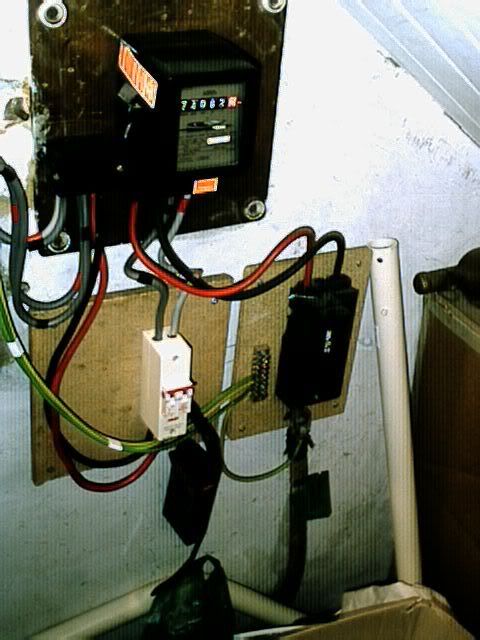Hi- I was round at a friend's house, checking the boiler in their basement while they were away and noticed a big old ugly main incomer feeding their consumer unit. The incomer's covered in a kind of hardened cloth tape and below that, where the MET clamp is connected, it seems to be have a spiral wrapping of steel.
Just by chance, as I had my trusty meter with me, I happened to check the EFLI and found it to be around 14 ohms. This was without isolating the system (didn't want to trigger the alarm system or anything) and without disconnecting the main equipotential bonding.
Concerned by this, I then went to various sockets in the house and checked the Zs. It read over 14 ohms on each one, with a PFC of only 16A. Not good, clearly!
Anyway, to cut to the chase, they are now back from holiday and a couple of days ago I went back to make a proper EFLI check, this time switching off at the main switch and disconnecting the main earth (and connecting my meter green lead to this). I got a reading of >2000 ohms on the meter (in fact, it couldn't carry out the test), i.e. no earth at all! When I reconnected the earth to the bar, I got the 14 ohm reading again.
My conclusion is that the only earthing they have is coming via the gas/water pipework and that the earth on the supply cable is not actually connected to earth at the transformer. It has been this way for years, it seems. Of course, I impressed upon them the need to call the LEB immediately, and hopefully they'll have that fixed by now.
It is shocking (!) that whoever made the connection from the CU to the supply cable never actually tested to see if it was indeed an earth. Luckily, they have had had no problems (no-one has died and house hasn't burned down). But I wonder how many homes in the land are similarly unprotected?
Finally, as this house is on the same street as mine, where there is PME, should it be a straight-forward job to change their system to PME/TN-C-S by simply making a link at the neutral to the earth bar? Obviously, this is a job for the LEB, but I am curious.
Just by chance, as I had my trusty meter with me, I happened to check the EFLI and found it to be around 14 ohms. This was without isolating the system (didn't want to trigger the alarm system or anything) and without disconnecting the main equipotential bonding.
Concerned by this, I then went to various sockets in the house and checked the Zs. It read over 14 ohms on each one, with a PFC of only 16A. Not good, clearly!
Anyway, to cut to the chase, they are now back from holiday and a couple of days ago I went back to make a proper EFLI check, this time switching off at the main switch and disconnecting the main earth (and connecting my meter green lead to this). I got a reading of >2000 ohms on the meter (in fact, it couldn't carry out the test), i.e. no earth at all! When I reconnected the earth to the bar, I got the 14 ohm reading again.
My conclusion is that the only earthing they have is coming via the gas/water pipework and that the earth on the supply cable is not actually connected to earth at the transformer. It has been this way for years, it seems. Of course, I impressed upon them the need to call the LEB immediately, and hopefully they'll have that fixed by now.
It is shocking (!) that whoever made the connection from the CU to the supply cable never actually tested to see if it was indeed an earth. Luckily, they have had had no problems (no-one has died and house hasn't burned down). But I wonder how many homes in the land are similarly unprotected?
Finally, as this house is on the same street as mine, where there is PME, should it be a straight-forward job to change their system to PME/TN-C-S by simply making a link at the neutral to the earth bar? Obviously, this is a job for the LEB, but I am curious.



